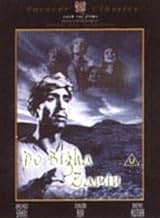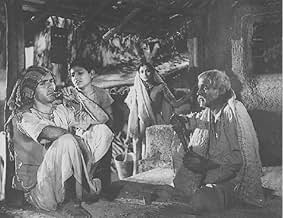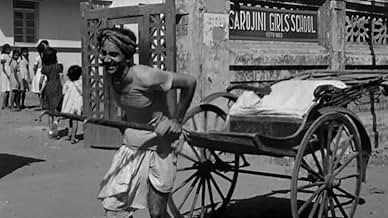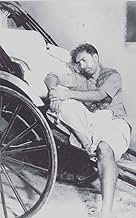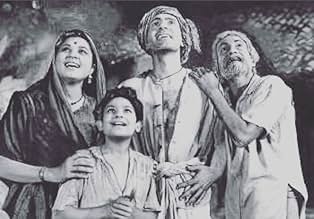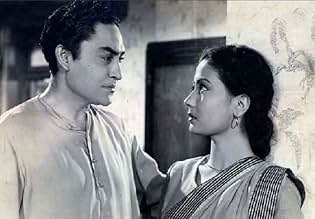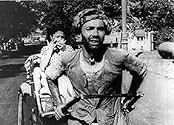AVALIAÇÃO DA IMDb
8,3/10
2,4 mil
SUA AVALIAÇÃO
Adicionar um enredo no seu idiomaIn the hope of earning enough money to pay off his debts and save his land, a poor farmer becomes a rickshaw puller in Calcutta and faces many difficulties.In the hope of earning enough money to pay off his debts and save his land, a poor farmer becomes a rickshaw puller in Calcutta and faces many difficulties.In the hope of earning enough money to pay off his debts and save his land, a poor farmer becomes a rickshaw puller in Calcutta and faces many difficulties.
- Direção
- Roteiristas
- Artistas
- Prêmios
- 4 vitórias e 1 indicação no total
Ratan Kumar
- Kanhaiya Maheto
- (as Rattan Kumar)
Rajlakshmi Devi
- Nayabji
- (as Rajlakshmi)
Nasir Hussain
- Rickshaw puller
- (as Nazir Hussain)
Ramayan Tiwari
- Paro's molester
- (as Tiwari)
- Direção
- Roteiristas
- Elenco e equipe completos
- Produção, bilheteria e muito mais no IMDbPro
Avaliações em destaque
Do Bigha Zamin is one of the pioneering films of 1950's starting the trend of parallel cinema. Bimal Roy like his other contemporary Bengali director in golden period of Indian film industry took an important social problem an converted into a 142min of struggle,misery and poverty. Protagonist Shambu (Balraj Sahni) is forced to sell his land 2 Bigha(unit) by Zameedar who wants to build a factory by demanding debt once given on interest.court ordered Shambu to pay in 3 months for which Shambu goes to Calcutta-the cruel city.city takes test of Shambu and his son Kanhaiya(Ratan Kumar) to save each penny. Balraj as usual looked perfect in his character of Shambu Mahto but for me real surprise was child artist Ratan Kumar who outplayed every other actor. Salil Chaudhary used music very smartly to not make film dramatic and keep it as real as possible.Bimal Roy was inspired from Vittorio De Sica's bicycle thieves which is landmark film in world cinema .2 Bigha Zameen was praised by critics internationally and won first Filmfar and international prize in Cannes. Bimal Roy's magic took our Shambu to the heart of west and still maintained Indian.
This movie is a must see. It shows poverty with a humanistic approach in 1953 India. I went to Calcutta in 1999 and people still ride on human rickshaws (a person runs barefoot on streets while pulling the rickshaws for few cents). It is a very sad. It is heart breaking. In this movie get to see a common man problems and how he or she deals with it. It shows how corrupted the rich are and using the poor for their own means. This is how a 1/3 of India lives in today hi tech India. This is how people are suffering with all the economic boom India has. This is how people live in today's Independent and Free India. This movie is a must see.
Post world war II, cinema was deeply influenced by the Italian realist wave. Rosselini and Visconti's hard hitting social commentary and De Sica's day-to-day struggle changed film-making like never before (or since). This wave gave birth to directors like Kurosawa, Fellini and Ray. One of the Indian masterpieces of those days was Bimal Roy's Do Bigha Zamin, which can arguably be termed as the Indian answer to De Sica's The Bicycle Thief.
This film has it's heart in the right place. The indivisible nature of the family, all of whose members work towards the fulfillment of a single objective, which is the fabric of Indian society, is the beauty of the film. All of the members- Shambhu, his wife, his father and son, intend to alleviate his situation and try to contribute in every way possible. The film ends in a sad satirical note, which is the principle characteristic of neo-realistic cinema.
Story apart, the most beautiful aspect of the film is the spirit with which on upholding of one's dignity and self esteem in the most perturbing situations. Though, the protagonist, Shambhu could have executed his task easily many ways, he opts for the most ethical choice of all- hard work. It is quite evident that Do Bhiga Zamin has been influenced by (and has influenced) cinema spanning different geographical, linguistic, and social backgrounds, but it still has a firm foot in its culture.
This film has it's heart in the right place. The indivisible nature of the family, all of whose members work towards the fulfillment of a single objective, which is the fabric of Indian society, is the beauty of the film. All of the members- Shambhu, his wife, his father and son, intend to alleviate his situation and try to contribute in every way possible. The film ends in a sad satirical note, which is the principle characteristic of neo-realistic cinema.
Story apart, the most beautiful aspect of the film is the spirit with which on upholding of one's dignity and self esteem in the most perturbing situations. Though, the protagonist, Shambhu could have executed his task easily many ways, he opts for the most ethical choice of all- hard work. It is quite evident that Do Bhiga Zamin has been influenced by (and has influenced) cinema spanning different geographical, linguistic, and social backgrounds, but it still has a firm foot in its culture.
Of course it is true that Do Bigha Zamin is strongly influenced by Vittorio de Sica's neorealist classic Bicycle Thieves (very improperly retitled Bicycle Thief in the English version). But De Sica's film has influenced virtually every realist film (and many non-realist films) ever since the day it first appeared. It is a crucial reference in world cinema and will probably always remain one.
It was of course particularly influential on all the Indian neo-realists of the fifties, including the greatest of them all - Satyajit Ray. Roy, like Ray a Bengali, would have imbibed that influence before ever he abandoned New Theatres in Calcutta to come to Bombay. He is not an especially innovative director. Devdas (1955) for instance is essentially a Hindi remake of a thirties classic of Bengali cinema; other Roy films show an eclectic range of influences. So it is not surprising to find him in Do Bigha Zamin attempting to adapt the style (and to some extent) the structure of Bicycle Thieves to an Indian context.
Once one has admitted that, however, it should not I think be seen as some sort of shameful plagiarism and one can go on to appreciate some of the real plusses of Roy's film. It is true that it is less restrained than the Italian model; Roy piles on the agony in no uncertain terms and tends to oversentimentalize. Note however that he resists any facile optimism...
The adaptation to a rural Indian context alters the politics of the film, concentrating on the issue (a burning issue to this day in rural India) of the cycle of debt and exploitation to which small peasant farmers in India are subjected (a theme that Mehboob Kahn had already explored in his film Aurat and would do again most famously in Mother India in 1957). This is a less subtle theme perhaps than that of De Sica (where in an urban context it is the poor who steal from the poor and prolong the cycle of misery) but it is nonetheless an important one and Roy (and Balraj Sahni who is excellent) paints a convincing picture of village-life and rural values.
Roy very deliberately counterbalances the picture of misery (rural and urban) with examples of solidarity, of the poor helping the poor, whether on the level of the adults or of the street-boys. And perhaps the most touching and most natural part of Roy's film - and something that owes nothing to De Sica - is his portrayal of the street-kids of Calcutta (which very interestingly prefigures Mira Nair's much later Salaam Bombay). Instead of being isolated companions as in the De Sica film, the father and son in Roy's film experience two rather different aspects of urban life and this layering of the story is perhaps Roy's most significant achievement.
Can one put paid once and for all, finally, to this idea that a realistic film or a film showing social awareness is uncharacteristic of Indian cinema (based on an essentially modern image of "Bollywood")? The golden age of Indian cinema (say 1949 to 1964) abounds in realistic films and films which, while not necessarily realistic in a strict sense of the term, show a good deal of social awareness. It is the period that includes the most memorable films of Satyajit Ray, Rithwik Gathak and Tapan Sinha, the films of Guru Dutt, the early films of Raj Kapoor, those of Bimal Roy, Mehboob Kahn's Mother India but also amongst relatively minor films, Arora's Boot Polish and B R Chopra's Naya Daur. To say nothing of great films in a non-realistic genre such as Mughal-e-Azam (1960) and Pakeezah (largely filmed during the period although not completed until 1972). By comparison with any contemporary cinema anywhere in the world including certainly American cinema, including even that of Japan (also experiencing something of a golden age at that time), it is a very impressive record.
Roy may not be amongst the first rank of cinematic geniuses - I would not put him in the same class as Ray or Gathak or for that matter as Guru Dutt, in my view the finest of the Hindi film directors of the period. He was a populariser (quite determinedly so) and constituted as such an important bridge between the more 'arty' Bengali and more 'popular' Hindi film industries of the time. His contribution remains an important and enduring one to an Indian cinema (and a popular Indian cinema) of real quality that has nothing to do with "Bollywood"...
It was of course particularly influential on all the Indian neo-realists of the fifties, including the greatest of them all - Satyajit Ray. Roy, like Ray a Bengali, would have imbibed that influence before ever he abandoned New Theatres in Calcutta to come to Bombay. He is not an especially innovative director. Devdas (1955) for instance is essentially a Hindi remake of a thirties classic of Bengali cinema; other Roy films show an eclectic range of influences. So it is not surprising to find him in Do Bigha Zamin attempting to adapt the style (and to some extent) the structure of Bicycle Thieves to an Indian context.
Once one has admitted that, however, it should not I think be seen as some sort of shameful plagiarism and one can go on to appreciate some of the real plusses of Roy's film. It is true that it is less restrained than the Italian model; Roy piles on the agony in no uncertain terms and tends to oversentimentalize. Note however that he resists any facile optimism...
The adaptation to a rural Indian context alters the politics of the film, concentrating on the issue (a burning issue to this day in rural India) of the cycle of debt and exploitation to which small peasant farmers in India are subjected (a theme that Mehboob Kahn had already explored in his film Aurat and would do again most famously in Mother India in 1957). This is a less subtle theme perhaps than that of De Sica (where in an urban context it is the poor who steal from the poor and prolong the cycle of misery) but it is nonetheless an important one and Roy (and Balraj Sahni who is excellent) paints a convincing picture of village-life and rural values.
Roy very deliberately counterbalances the picture of misery (rural and urban) with examples of solidarity, of the poor helping the poor, whether on the level of the adults or of the street-boys. And perhaps the most touching and most natural part of Roy's film - and something that owes nothing to De Sica - is his portrayal of the street-kids of Calcutta (which very interestingly prefigures Mira Nair's much later Salaam Bombay). Instead of being isolated companions as in the De Sica film, the father and son in Roy's film experience two rather different aspects of urban life and this layering of the story is perhaps Roy's most significant achievement.
Can one put paid once and for all, finally, to this idea that a realistic film or a film showing social awareness is uncharacteristic of Indian cinema (based on an essentially modern image of "Bollywood")? The golden age of Indian cinema (say 1949 to 1964) abounds in realistic films and films which, while not necessarily realistic in a strict sense of the term, show a good deal of social awareness. It is the period that includes the most memorable films of Satyajit Ray, Rithwik Gathak and Tapan Sinha, the films of Guru Dutt, the early films of Raj Kapoor, those of Bimal Roy, Mehboob Kahn's Mother India but also amongst relatively minor films, Arora's Boot Polish and B R Chopra's Naya Daur. To say nothing of great films in a non-realistic genre such as Mughal-e-Azam (1960) and Pakeezah (largely filmed during the period although not completed until 1972). By comparison with any contemporary cinema anywhere in the world including certainly American cinema, including even that of Japan (also experiencing something of a golden age at that time), it is a very impressive record.
Roy may not be amongst the first rank of cinematic geniuses - I would not put him in the same class as Ray or Gathak or for that matter as Guru Dutt, in my view the finest of the Hindi film directors of the period. He was a populariser (quite determinedly so) and constituted as such an important bridge between the more 'arty' Bengali and more 'popular' Hindi film industries of the time. His contribution remains an important and enduring one to an Indian cinema (and a popular Indian cinema) of real quality that has nothing to do with "Bollywood"...
I have seen Do Bigha Zamin many times ( at least five ) but never had a chance to write a review. Every time I see this movie I put my hats off to Mr. Bimal Roy as the director of this masterpiece. I have read comments about having the idea from a different film ( Vittorio Di Sica's Bicycle Thief ) But I can challenge a lot of director to copy any film they want and produce something like Do Bigha Zamin. The scenes of a village in Bengal and the streets of Calcutta ( now Kolkata ) in early fifties are so real - it just sends shivers through my body. I was a student in a Calcutta college during that period and the scenes from Esplanade area, with Metro Cinema, Chowringhee Road, the double decker buses, the trams and finally the human rickshaws were presented in such a way that I felt being there in that period. The poverty of the villagers and as well as the bustee dwellers were very realistic and the characters were portrayed and played extremely well. Some of the scenes like when Paro went to Meena Kumari to get a letter written, the short scene where Nirupa Roy complaining to Balraj Sahni that he does not love her are very touching scenes. One of the other wonders are the boot polish kid Laloo. I don,t know whether he is an actor or real boot polish kid in real life , but he displayed a wonderful piece of acting as the friendly companion to Kanhaiya ( Rattan Kumar ). Nirupa Roy as the wife of the peasant Balraj Sahani, Balraj Sahani himself and Rattan Kunmar all played their parts very well. I should also mention the role played by Rajlakhsmi Devi as the Bustee owner - what can be more realistic than that. Though the economic scene in India has changed over the last sixty years still there are a lot of poverty in India and peasants like Shambhu Mahato can be found all over India. I appreciate the director's last scene where it shows the family is still intact with hope for the future at the same time the struggle for survival goes on as they lost their land to the greedy landlord. I have the DVD and will watch it many more times.
Você sabia?
- CuriosidadesWhen the shoeshine boys discuss seeing Nargis in O Vagabundo (1951), one of them alludes to a shirt worn by a bystander. The shirt is decorated with a recurring pattern showing the famous scene from O Vagabundo (1951) in which Raj Kapoor comes upon Nargis as she is changing clothes, partially hidden by a screen, after swimming. That scene occupies a place in Hindi cinema comparable to that of Deborah Kerr and Burt Lancaster on the beach in A um Passo da Eternidade (1953).
- ConexõesFeatured in Century of Cinema: And the Show Goes On: Indian Chapter (1996)
- Trilhas sonorashariyaala saawan dhol bajaata aaya
Sung by Lata Mangeshkar, Manna Dey
Principais escolhas
Faça login para avaliar e ver a lista de recomendações personalizadas
- How long is Do Bigha Zamin?Fornecido pela Alexa
Detalhes
- Tempo de duração2 horas 11 minutos
- Cor
- Proporção
- 1.37 : 1
Contribua para esta página
Sugerir uma alteração ou adicionar conteúdo ausente

Principal brecha
By what name was Dois Acres de Terra (1953) officially released in Canada in English?
Responda

